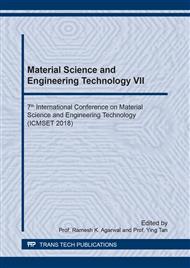p.160
p.165
p.170
p.175
p.180
p.185
p.190
p.195
p.200
Comparing the Effects of Ultrasonic System of the EDM Process on Machining Cemented Carbide
Abstract:
This research aim to improve the machining properties of the EDM for cemented carbide. The new methods were designed and proposed to use the ultrasonic vibration technique. Two types of USEDM systems were produced. One had a low frequency of 29 kHz with a large vibration amplitude, while the other had a high frequency of 59 kHz with a small amplitude. The Cu-W tool electrode was synchronized with the devised vibration system, and several discharge generation conditions were carried out on the cemented carbide material. The results showed that the highest machining efficiencies were obtained from the ultrasonic low frequency of 29 kHz with a large vibration amplitude. The MRR, TWR and surface roughness of the ultrasonic low frequency with the large vibration amplitude were better than the high frequency system with the small amplitude system. It was clarified that the ultrasonic vibration with the large amplitude could assist the material removal behavior of the discharge.
Info:
Periodical:
Pages:
195-199
Citation:
Online since:
April 2019
Authors:
Keywords:
Price:
Сopyright:
© 2019 Trans Tech Publications Ltd. All Rights Reserved
Share:
Citation:


